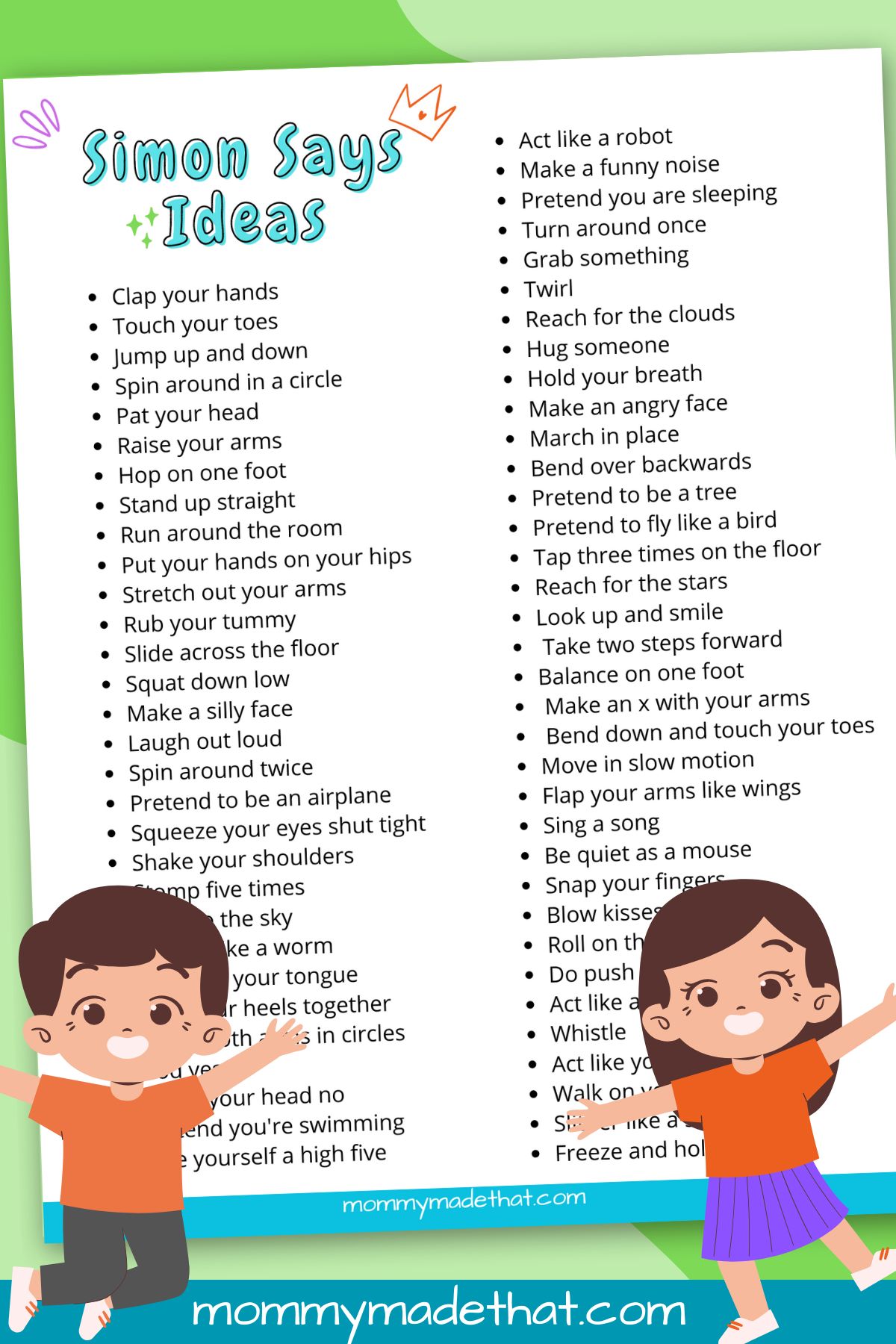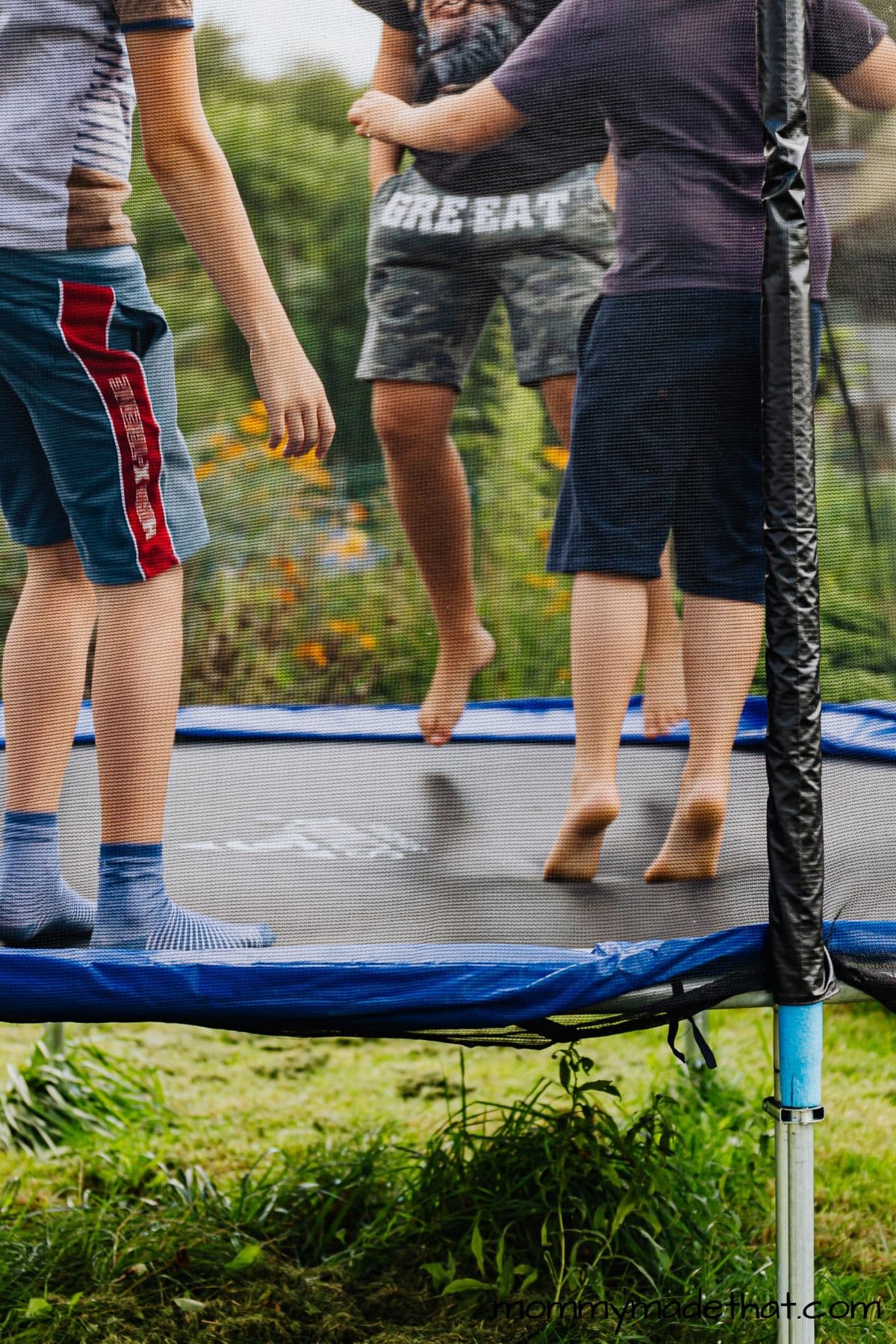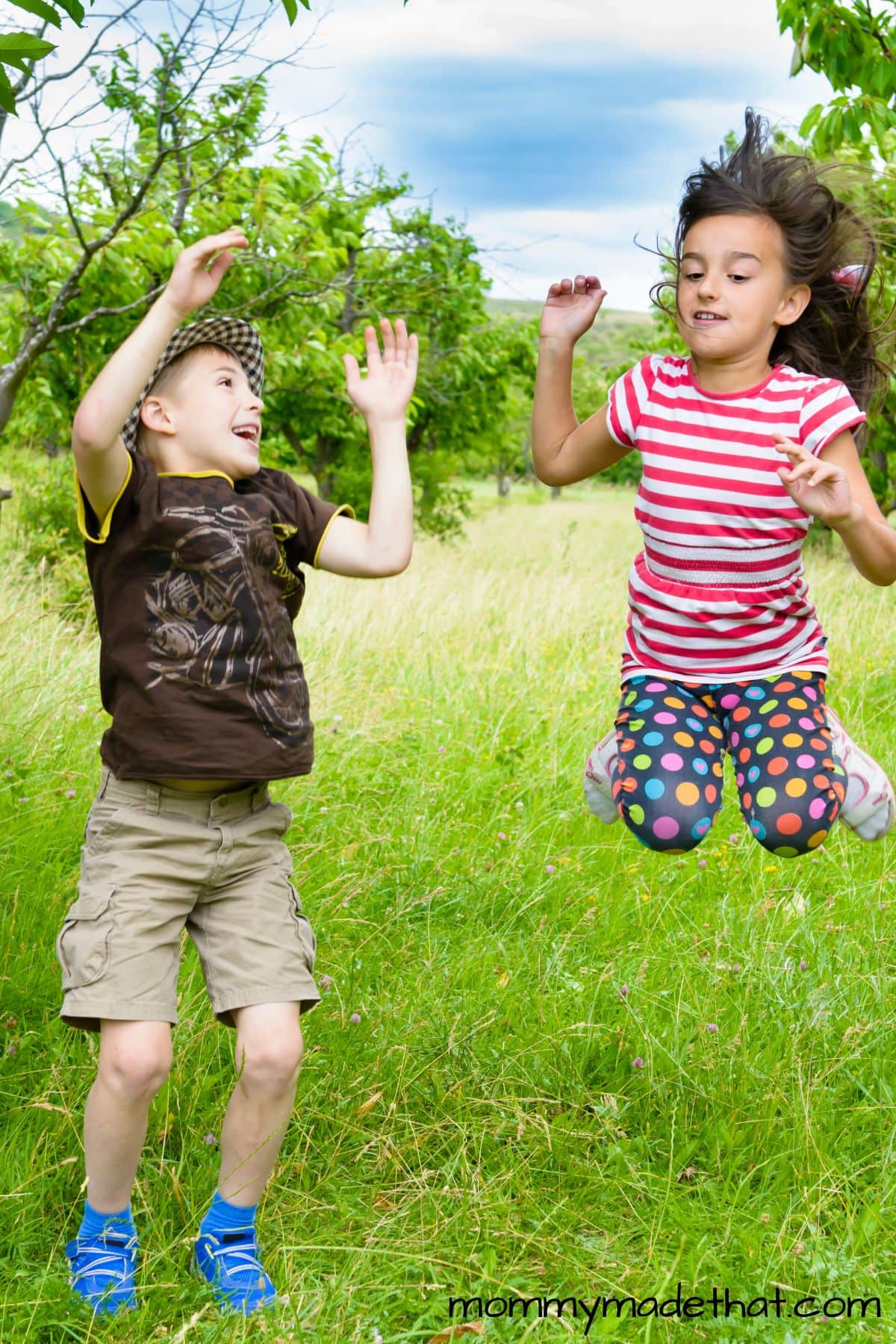Group Games for Kids: Ultimate List of Games!
Are you looking for fun ways to keep kids engaged and entertained while also promoting teamwork, socialization, and cognitive development?

Look no further than group games! Perfect for [age range] and groups of any size, these games are not only a blast to play but also provide numerous benefits that can help kids grow and thrive.
Playing group games promotes teamwork and cooperation, encouraging kids to work together towards a common goal.
It also enhances socialization skills, providing opportunities for kids to interact and communicate with their peers in a fun and low-pressure environment.
And let’s not forget about the cognitive benefits; playing games can improve problem-solving and decision-making skills, as well as provide opportunities for physical activity and exercise.
In this guide, we’ll be introducing [number of] group games that are sure to keep kids entertained and engaged for hours on end.
From classic games like Red Light, Green Light and Duck, Duck, Goose to more unique options like Scavenger Hunt and Two Truths and a Lie, there’s something for everyone.
So gather up your group, and get ready to have some fun!
Table of Contents
- Benefits of Group Games for Kids
- Red Light, Green Light
- Telephone Game
- Blob Tag
- Duck, Duck, Goose
- Simon Says
- Freeze Dance
- Hot Potato
- Mother, May I?
- Relay Races
- Tug of War
- Capture the Flag
- Kickball
- Balloon Volleyball
- Scavenger Hunt
- Water Balloon Toss
- Obstacle Course
- Sharks and Minnows
- Marco Polo
- Steal the Bacon
- Musical Chairs
Benefits of Group Games for Kids
Group games have always been an integral part of human interaction, from the smallest communities to the largest cities.
In today’s fast-paced world, where technology dominates much of our free time, it’s easy to forget the importance of playing together. However, group games offer numerous benefits that go far beyond just having fun.
In this article, we’ll explore the many advantages of group games and why you should consider incorporating them into your daily routine.
Teamwork and Cooperation
One of the most significant benefits of group games is their ability to promote teamwork and cooperation. Whether it’s a game of soccer, a scavenger hunt, or a round of musical chairs, group games require individuals to work together towards a common goal.
These games teach valuable lessons about communication and collaboration, allowing players to develop essential skills that are applicable in every aspect of life.
Socialization and Communication Skills
Playing group games also provides opportunities for socialization and communication. Group games allow players to interact with others in a structured setting, teaching them how to communicate effectively, listen actively, and express themselves clearly.
As children grow and develop, these skills become increasingly important in academic settings and everyday life.
Cognitive Development
Group games can also have a significant impact on cognitive development.
Games that require problem-solving, decision-making, and critical thinking skills can help players improve their cognitive abilities.
Physical Benefits
In addition to the cognitive and social benefits, group games also provide a range of physical benefits.
Many group games require players to engage in physical activity, providing an excellent opportunity for exercise and movement. Encouraging physical activity has become increasingly important as childhood obesity rates continue to rise.
By incorporating group games into daily routines, parents and educators can help children develop healthy habits that will benefit them throughout their lives.
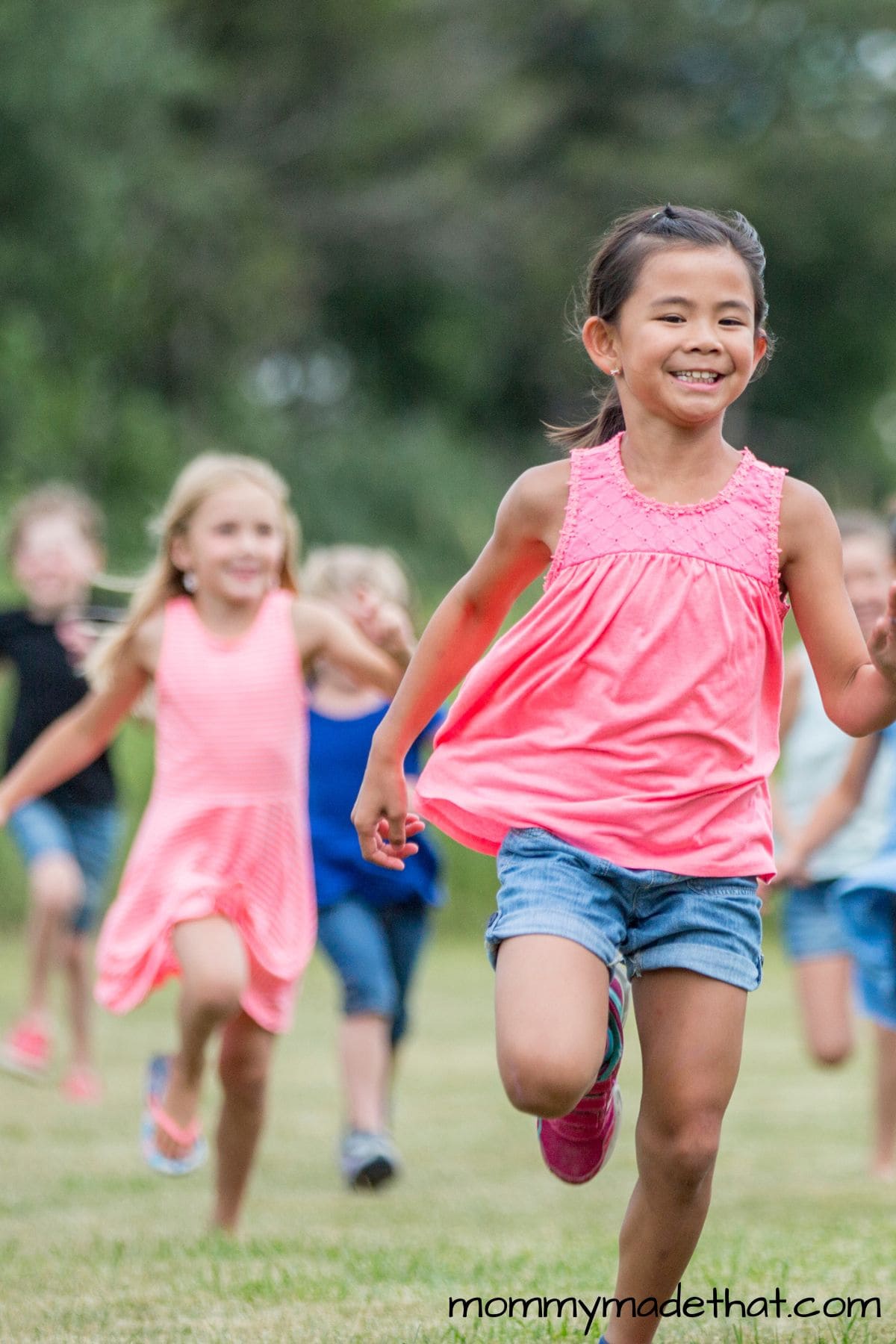
Red Light, Green Light
The Red Light, Green Light game is a classic game that’s perfect for groups of all ages.
How to Play:
To play, choose one player to be the “stoplight” and have them stand facing away from the other players. The remaining players line up behind the stoplight, with plenty of space between each person.
The stoplight then calls out “Green light!” and the players start moving forward. When the stoplight calls out “Red light!” all players must freeze in their tracks.
If the stoplight catches anyone moving after calling “Red light!” that player is out. The game continues until someone reaches the stoplight, who then becomes the new stoplight for the next round.
Equipment:
No equipment is necessary for Red Light, Green Light, making it a great game to play anywhere.
To modify the game for younger children, you can decrease the distance between the stoplight and the players or allow players to take baby steps instead of freezing completely.
For older children, you can increase the distance between the stoplights and the players or add obstacles for players to navigate while playing.

Telephone Game
the Telephone is a fun and entertaining game that tests your listening and communication skills. It’s perfect for parties, gatherings, or even just a simple family game night.
How to Play the Telephone Game:
To play, gather all the players in a circle or a straight line. The first player whispers a message or phrase into the ear of the person next to them.
That person then whispers what they heard to the person next to them, and so on down the line.
The last person to receive the message says it out loud, and the group compares it to the original message.
Often, the final message will be hilariously different from the original, showcasing how easily information can get distorted through multiple retellings.
Equipment:
No equipment is needed for Telephone, making it an easy game to set up and play anywhere.
To modify the game for younger children, you can use shorter, simpler phrases to make it easier for them to remember and pass along the message.
For older children, you can increase the difficulty by using longer phrases, adding background noise, or introducing a rule where players must whisper the message only once. This will test their listening skills and make the game more challenging and entertaining.
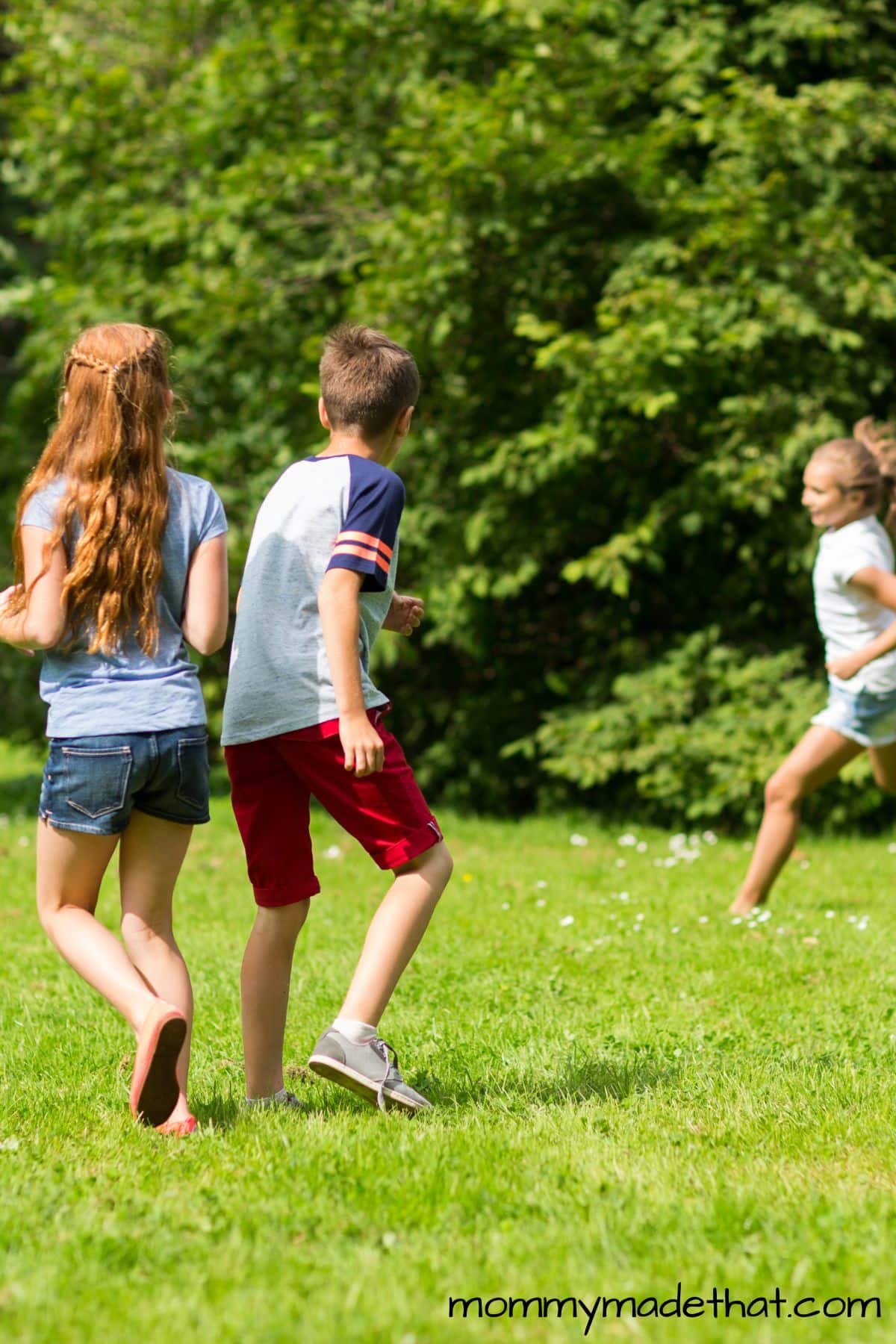
Blob Tag
Blob Tag is a fun and engaging game that works well for larger groups. This is one of the lesser know group games for kids, but still a goodie!
How to Play:
To play, choose one player to be the “blob” and have them chase after the other players. When the blob catches someone, they join hands to form a chain.
The chain then chases after the remaining players, trying to catch them and add them to the chain.
The game continues until everyone is part of the blob. Players can break off from the chain if they manage to tag the last person in the chain, causing the chain to split into two separate blobs.
The game is over when one large blob has formed, and everyone is part of it.
Equipment:
No equipment is necessary to play Blob Tag, making it an excellent game to play anywhere.
To modify the game for younger children, you can decrease the size of the playing area or have players hold hands instead of linking arms to form the chain.
For older children, you can increase the size of the playing area or add obstacles for players to navigate while playing.
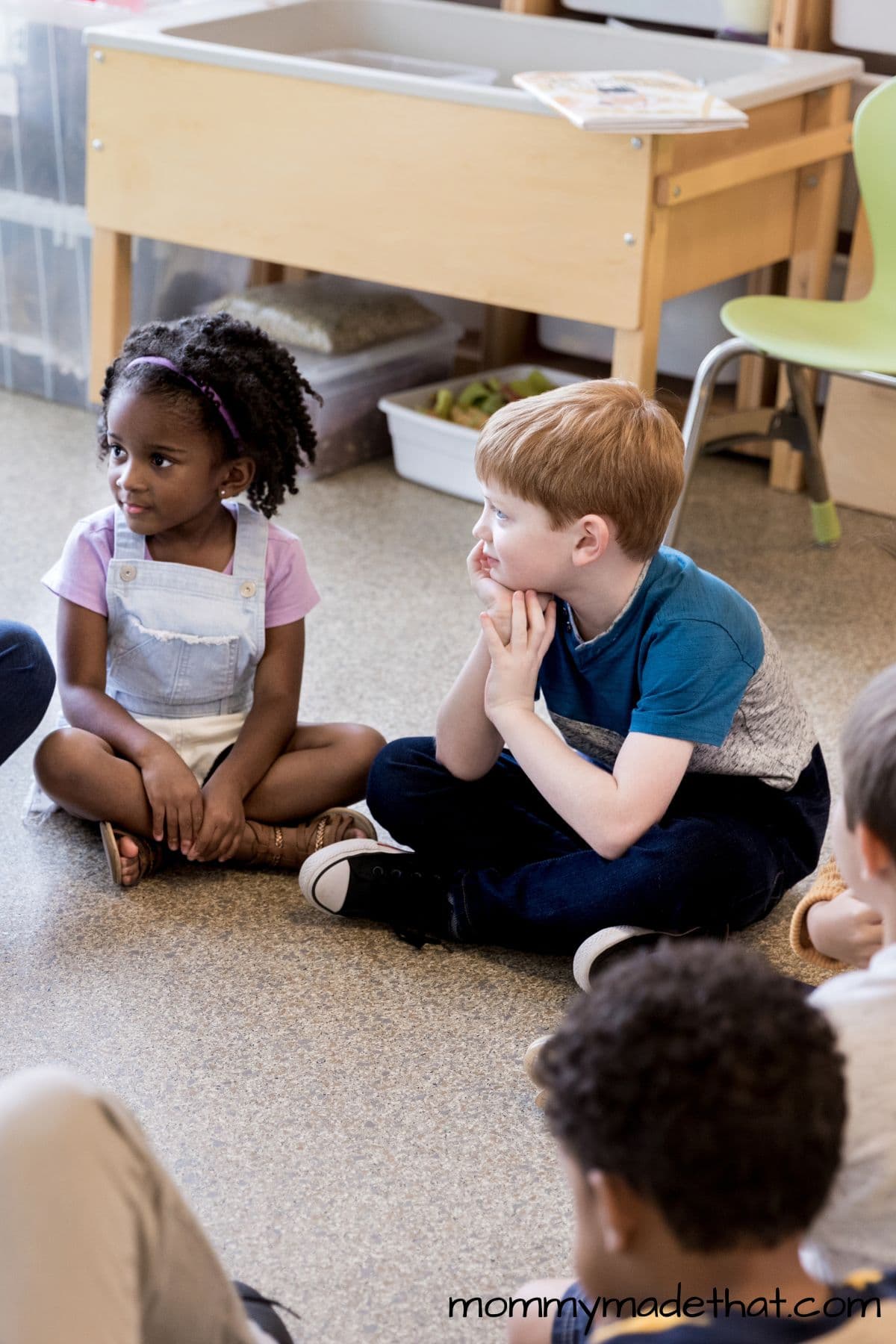
Duck, Duck, Goose
Duck, Duck, Goose is another classic game that’s ideal for groups of all ages. It’s great for younger kids and is a great indoor game or outdoor game.
To play, have all players sit in a circle, facing each other, and choose one player to be the “goose.”
The goose walks around the outside of the circle, tapping each player on the head and saying “duck” until they tap someone and say “goose.”
The chosen player becomes the new goose and chases after the previous goose, who must run around the circle and try to make it back to their spot before being caught.
If the previous goose is caught, they must take another turn as the goose. If they make it back to their spot, the new goose starts the game again.
Equipment:
No equipment is necessary for Duck, Duck, Goose, making it an excellent game to play anywhere.
To modify the game for younger children, you can decrease the size of the circle or have them walk instead of run when they’re the goose.
For older children, you can increase the size of the circle or add rules such as requiring geese to touch a designated object before returning to their spot.

Simon Says
The Simon Says game that helps children develop listening skills and follow instructions.
How to Play Simon Says:
To play, choose one player to be “Simon” and have them stand in front of the other players. Simon then gives commands starting with “Simon says,” such as “Simon says, touch your toes” or “Simon says, jump up and down.”
All players must follow the instructions only if Simon says “Simon says” before the command. If Simon gives a command without saying “Simon says,” and a player follows it, they are out of the game.
The game continues until there is only one player left. That player becomes the new Simon and starts the game again.
If you need help with commands we’ve got lots of great simon says ideas.
Equipment:
No equipment is necessary for Simon Says, making it an excellent game to play anywhere.
To modify the game for younger children, you can start with simple commands and increase the difficulty as the game progresses.
For older children, you can add physical challenges or limit the time players have to complete the commands.
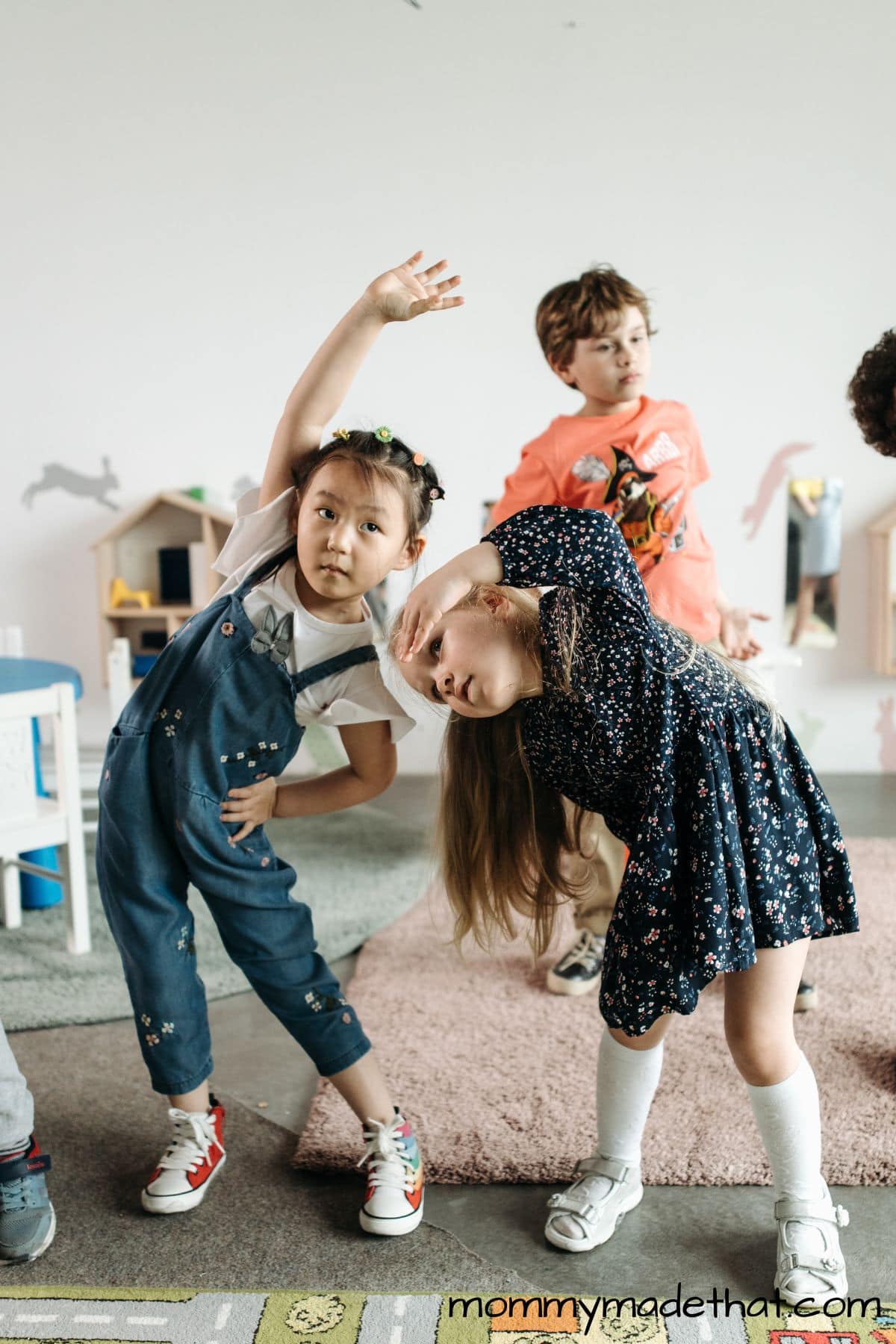
Freeze Dance
Freeze Dance is a fun group game for kids that combines music and movement.
To play, have all players start dancing when the music begins, and when it stops, they must freeze in place. Any players caught moving after the music stops are out of the game. The game continues until one player remains.
Equipment:
No equipment is necessary for Freeze Dance, making it an excellent game to play anywhere.
To modify the game for younger children, you can play slower music and allow players to continue dancing slowly during the freeze portion of the game.
For older children, you can add more complex dance moves or limit the amount of time players have to freeze.
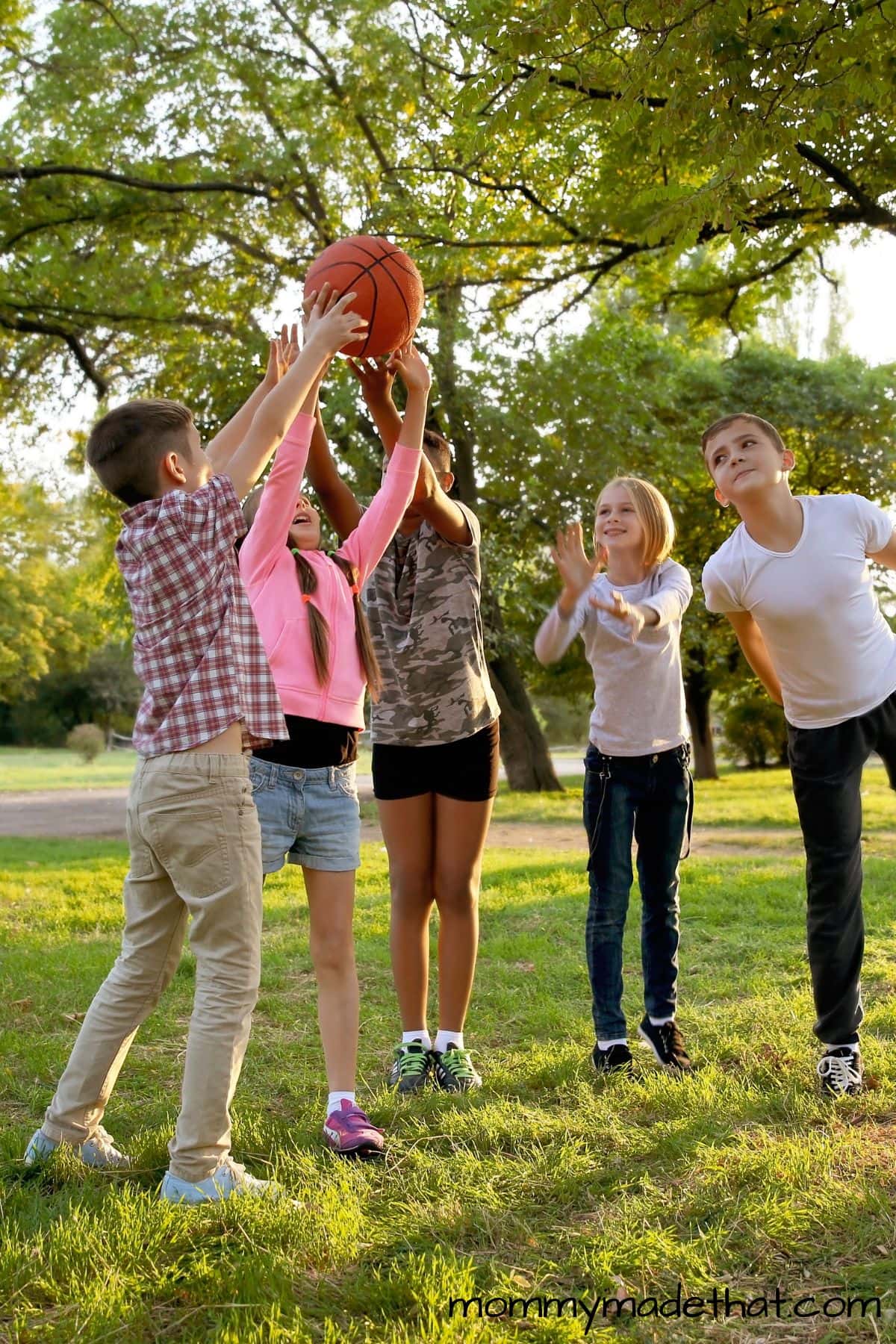
Hot Potato
The Hot Potato game is a classic game that’s easy to play and can be enjoyed by children of all ages.
How to Play:
All players sit in a circle and pass a small object, such as a ball or a potato, around while music plays.
When the music stops, whoever is holding the object is out of the game. The game continues until only one player remains.
Equipment:
No equipment is necessary for Hot Potato, making it an excellent game to play anywhere.
To modify the game for younger children, you can play slower music and make the object larger and easier to catch.
For older children, you can add more rules, such as requiring players to say a certain word or phrase when they pass the object.
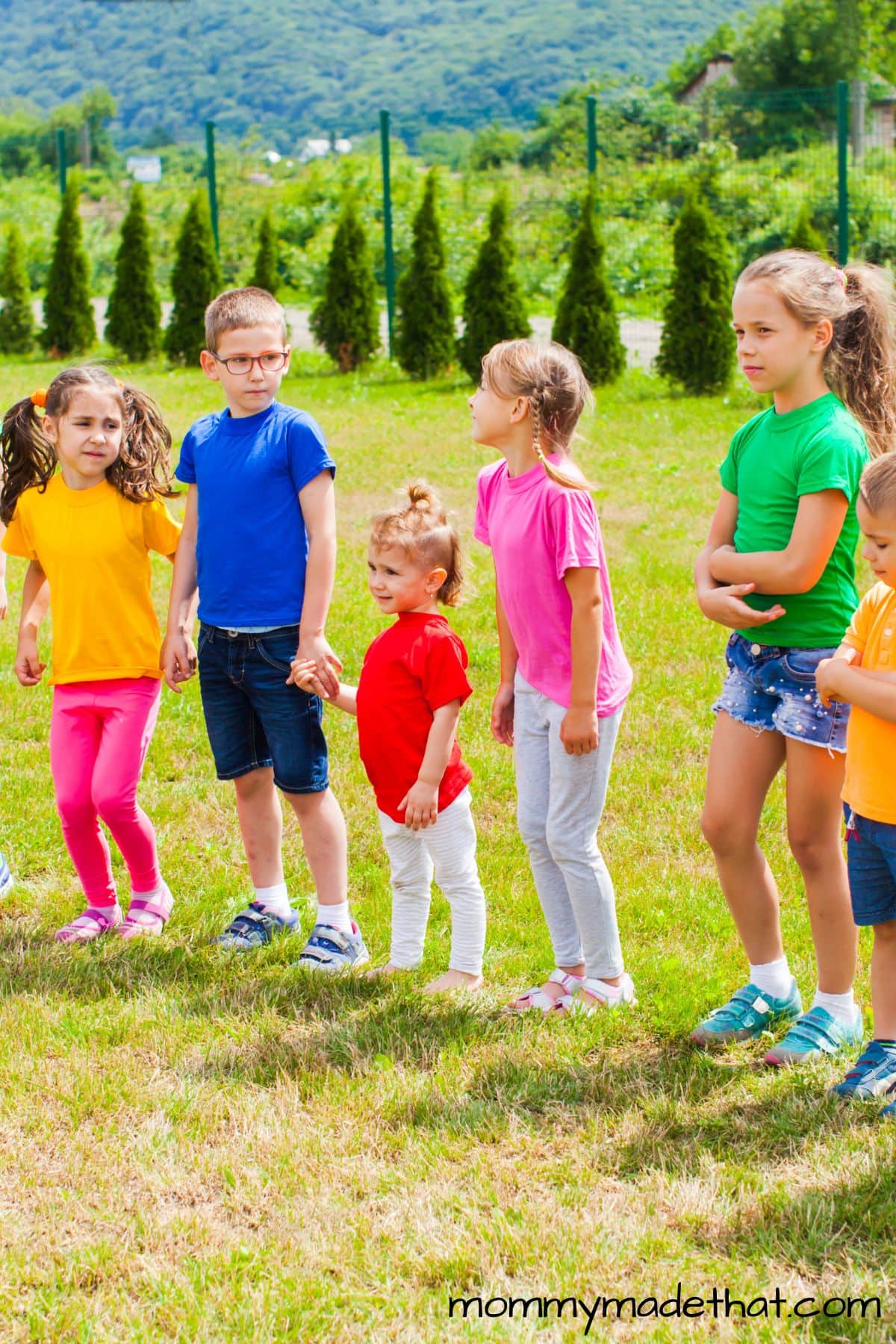
Mother, May I?
Mother, May I? is a classic game that helps children practice listening skills and follow instructions. This is a great if you’re looking for indoor group games.
To play, choose one player to be “Mother” (or “Captain” for a more gender-neutral option) and have them stand facing away from the other players.
The remaining players line up behind a starting line, with plenty of space between each person.
The players take turns asking, “Mother, may I [perform an action]?” For example, “Mother, may I take three giant steps forward?” Mother then responds with either “Yes, you may” or “No, you may not,” sometimes suggesting an alternative action.
Players must follow Mother’s instructions and only move if they’ve been granted permission. The first player to reach Mother wins and becomes the new Mother for the next round.
Equipment:
No equipment is necessary for Mother, May I?, making it a great game to play anywhere.
To modify the game for younger children, you can use simpler actions like small steps or hops.
For older children, you can introduce more complex actions like cartwheels or somersaults or add obstacles for players to navigate while playing.
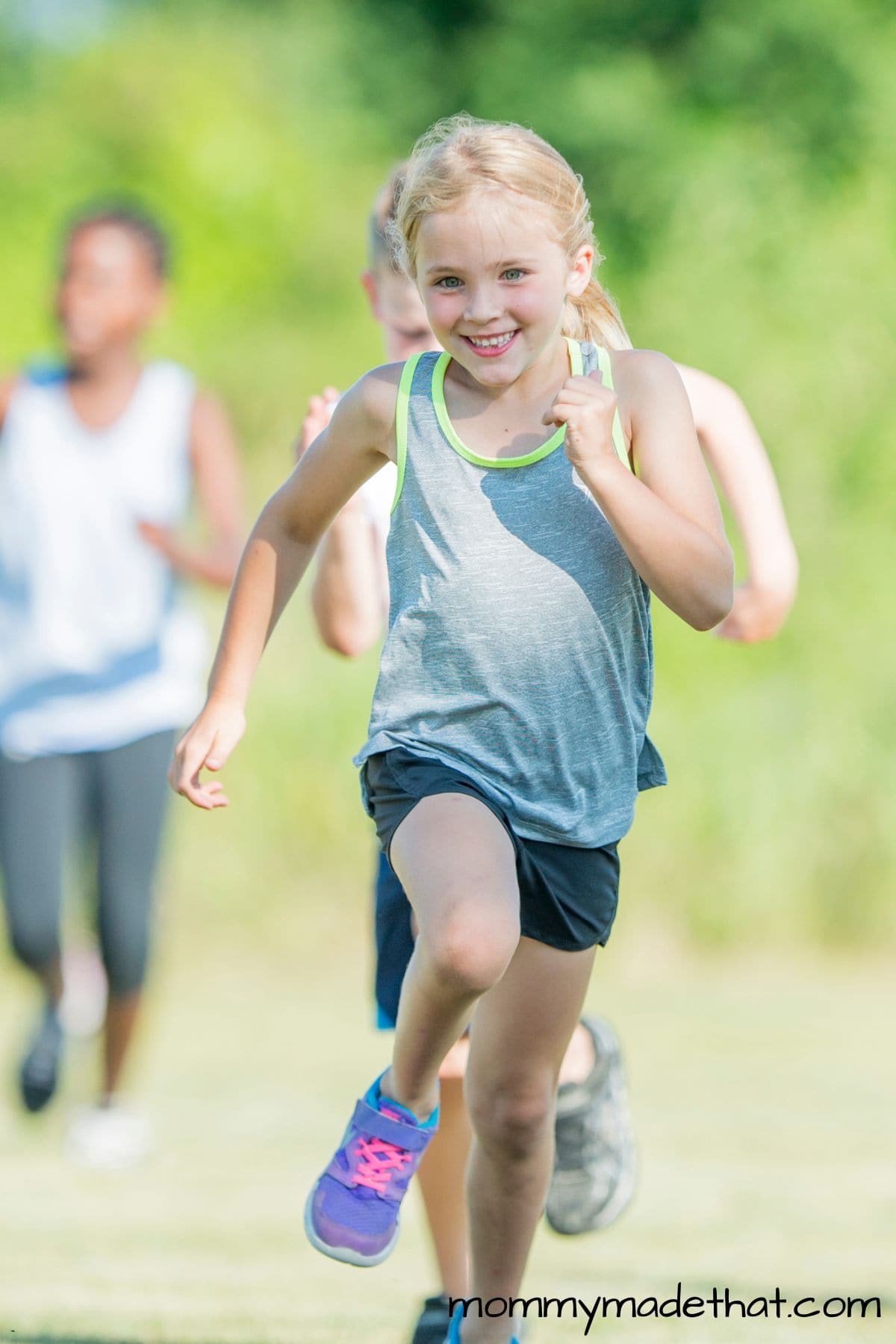
Relay Races
Relay races are an excellent way to promote teamwork and physical activity among children.
How to Play:
To play, divide the group into two or more teams and have each team line up behind a designated starting line.
The first player from each team performs a specific action, such as running, hopping, or carrying an object, to reach a designated endpoint and then returns to their team, passing the baton (or performing a high-five) to the next player in line.
The race continues until all team members have completed the action.
Equipment:
Equipment needed for relay races may vary depending on the type of race. Items like batons, hula hoops, or bean bags may be used in different relay race variations.
To modify the game for younger children, you can use simpler actions or decrease the distance between the starting line and the endpoint.
For older children, you can increase the distance or introduce more complex actions and additional obstacles.
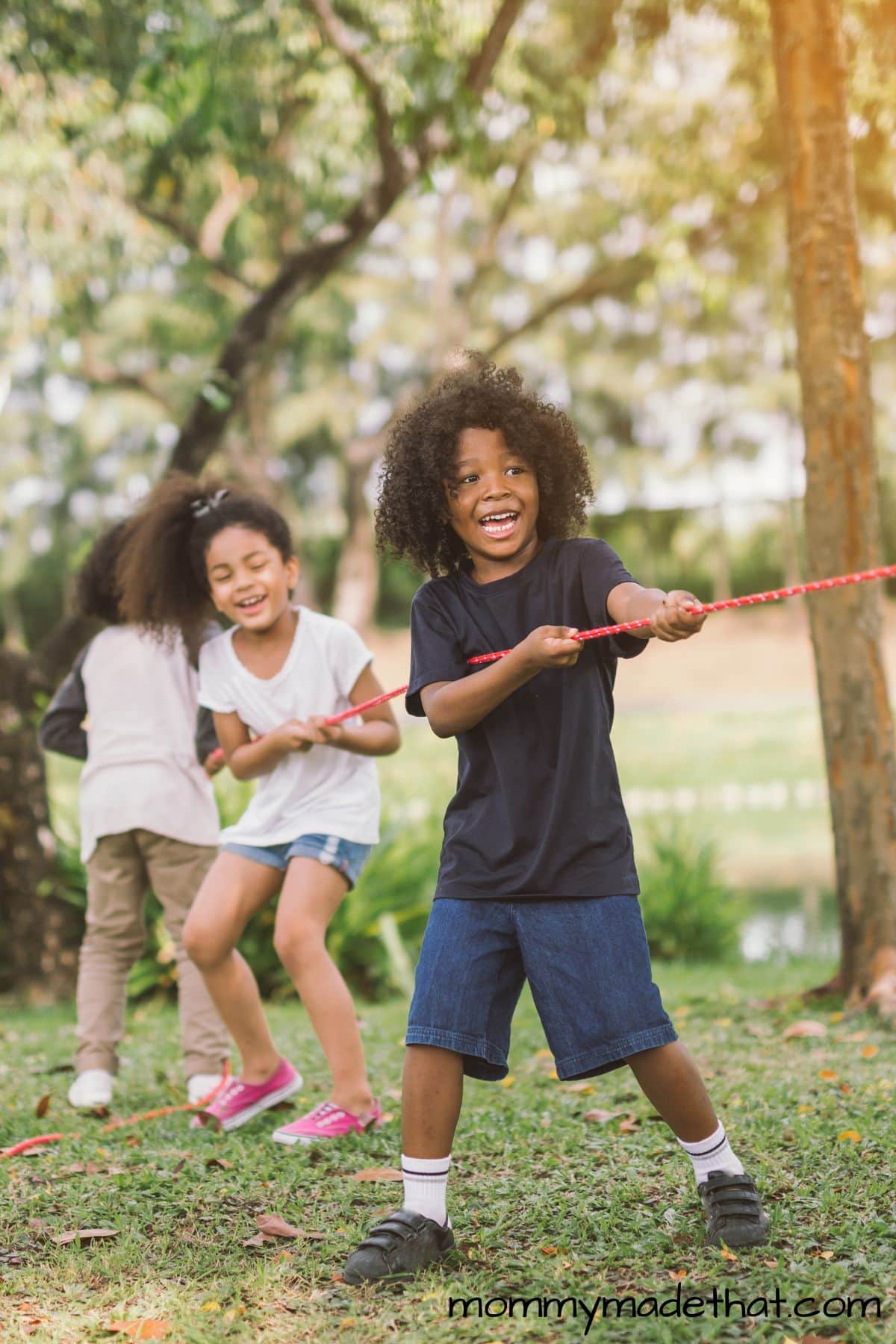
Tug of War
Tug of War is a classic team game that promotes strength, teamwork, and friendly competition.
How to Play:
To play, divide the group into two equal teams and have them stand on opposite sides of a long rope. Mark a center line on the ground and place a flag or another marker at the midpoint of the rope.
The objective of the game is for each team to pull the rope towards their side until the flag crosses the center line, indicating a win for that team.
The game can be played in multiple rounds, with the winning team being the one that wins the most rounds.
Equipment:
Equipment needed for Tug-of-War includes a long, sturdy rope and a flag or marker to indicate the midpoint.
To modify the game for younger children, you can use a shorter rope or create smaller teams to make it easier to pull.
For older children, you can increase the length of the rope or introduce additional challenges, like playing on an uneven or slippery surface.
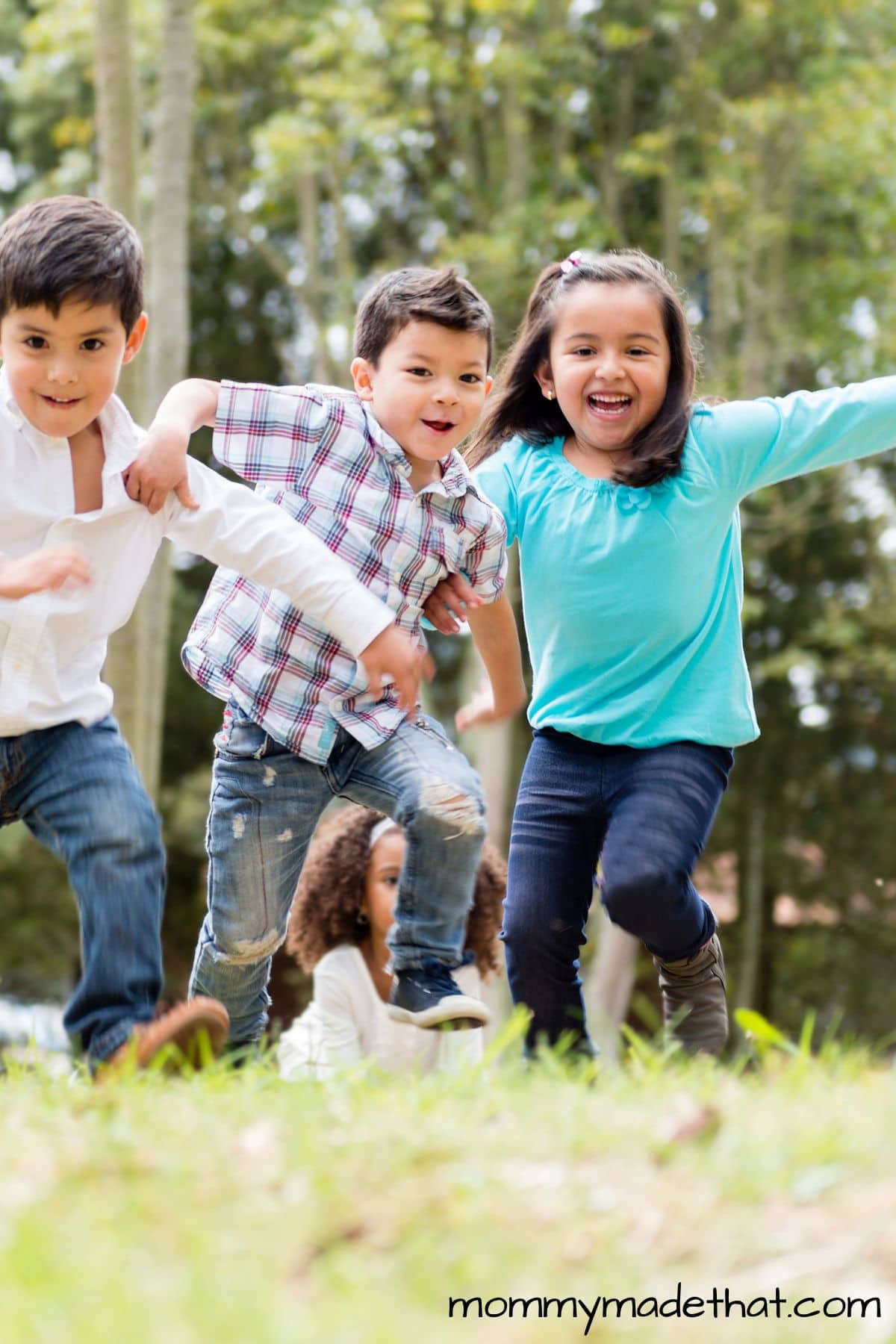
Capture the Flag
Capture the Flag is a fun and strategic game that encourages teamwork, communication, and physical activity.
How to Play:
To play, divide the group into two teams and designate a playing area with two halves, one for each team.
Each team has a flag or an object representing a flag placed at their end of the playing area.
The objective of the game is for each team to steal the other team’s flag and bring it back to their side without being tagged by the opposing team members.
If a player is tagged while in the opposing team’s territory, they are sent to a designated “jail” area until a teammate frees them by tagging them.
The first team to successfully capture the other team’s flag and bring it back to their side wins.
Equipment:
Equipment needed for Capture the Flag includes two flags or objects to represent flags and markers to designate the playing area boundaries.
To modify the game for younger children, you can decrease the size of the playing area or create smaller teams.
For older children, you can increase the size of the playing area, add multiple flags per team, or introduce additional obstacles and challenges.
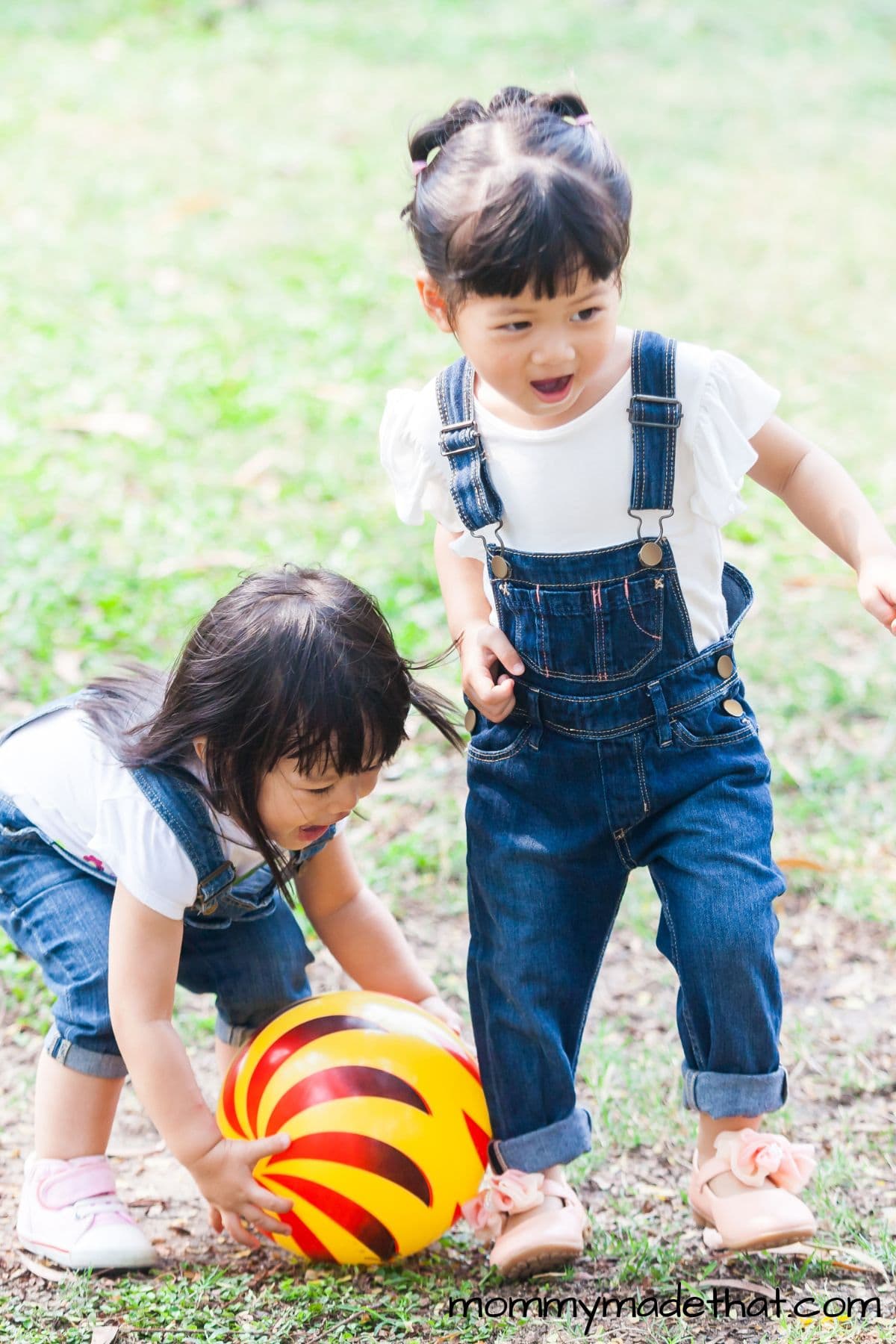
Kickball
Kickball is a fun and engaging game that combines elements of baseball and soccer.
How to Play:
To play, divide the group into two teams and set up a playing field with four bases in a diamond shape, similar to a baseball field. One team starts as the fielding team, while the other team lines up to kick.
The pitcher rolls a ball towards the kicker, who then kicks it and tries to reach a base before the fielding team can catch the ball and tag them out.
The kicking team scores a point when a player makes it around all four bases and back to home plate. Once all players on the kicking team have had a turn, the teams switch roles.
The game continues for a predetermined number of innings, and the team with the most points wins.
Equipment:
Equipment needed for Kickball includes a rubber playground ball and markers or cones to designate the bases.
To modify the game for younger children, you can use a larger ball, decrease the distance between bases, or allow for more lenient rules.
For older children, you can increase the distance between bases or introduce additional rules and challenges.
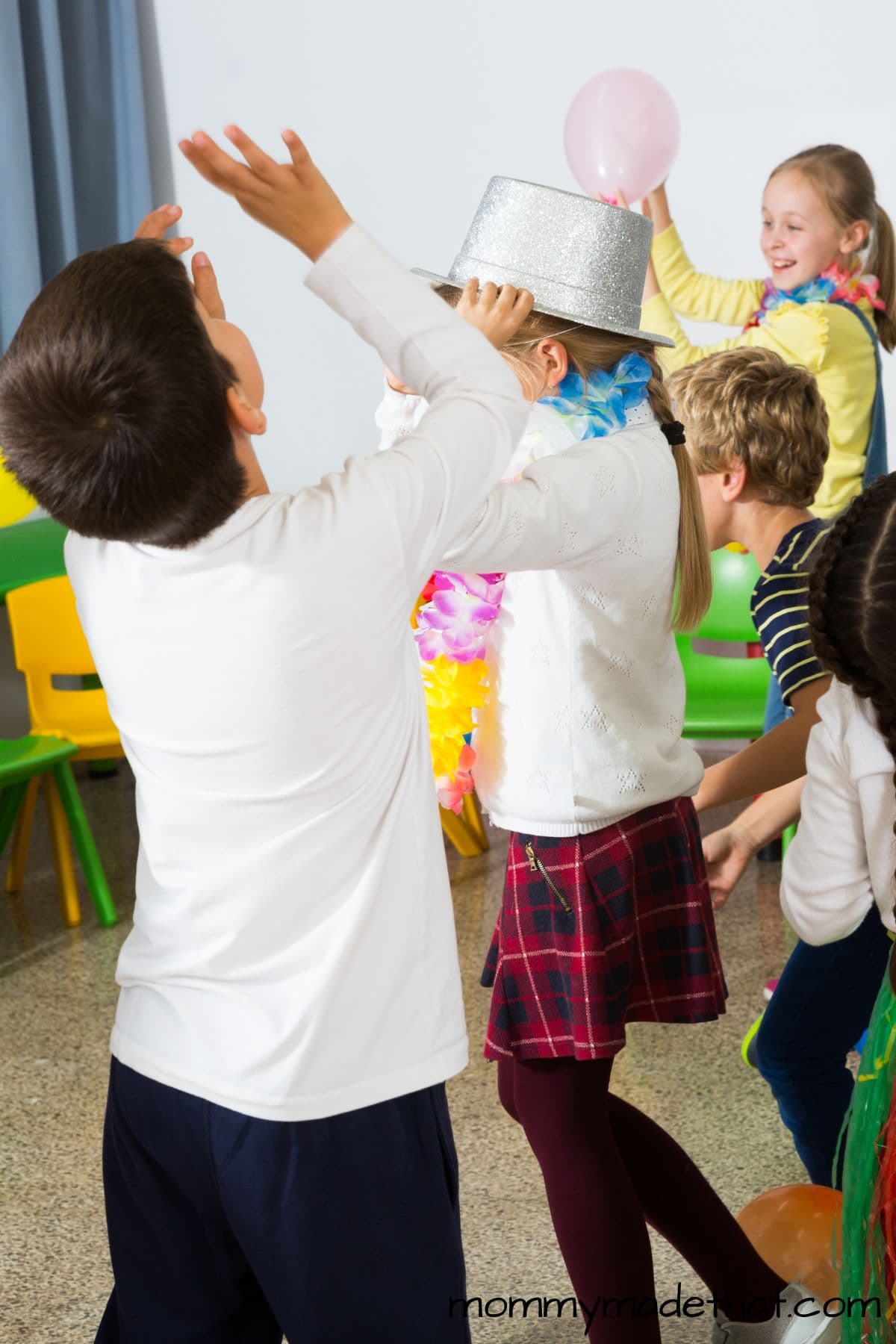
Balloon Volleyball
Balloon Volleyball is a safe and enjoyable game that can be played indoors or outdoors.
How to Play:
To play, divide the group into two teams and set up a playing area with a net or a line dividing the space into two halves. Each team stands on their side of the net or line.
The objective of the game is to keep the balloon in the air and hit it over the net or line into the opposing team’s side without letting it touch the ground.
If the balloon lands on a team’s side, the other team scores a point.
The game continues until a predetermined number of points are reached or for a set amount of time.
Equipment:
Equipment needed for Balloon Volleyball includes a balloon and a net or a line to divide the playing area.
To modify the game for younger children, you can use a larger balloon, lower the net height, or allow for more lenient rules.
For older children, you can increase the size of the playing area or introduce additional rules and challenges, such as limiting the number of hits per side or requiring specific types of hits.

Scavenger Hunt
Scavenger Hunt is an exciting game that encourages problem-solving, observation, and teamwork.
How to Play:
To play, create a list of items or tasks that players must find or complete within a designated area.
Divide the group into teams and provide each team with a copy of the list.
Set a time limit for the game, and the teams must work together to find or complete as many items or tasks on the list as possible before time runs out.
Equipment:
Equipment needed for a Scavenger Hunt may vary depending on the specific items or tasks involved. You will need a list of items or tasks and a timer to track the time limit.
To modify the game for younger children, you can create a shorter list, use picture clues, or decrease the difficulty of the tasks.
For older children, you can increase the complexity of the tasks, add riddles or puzzles to solve, or extend the playing area.
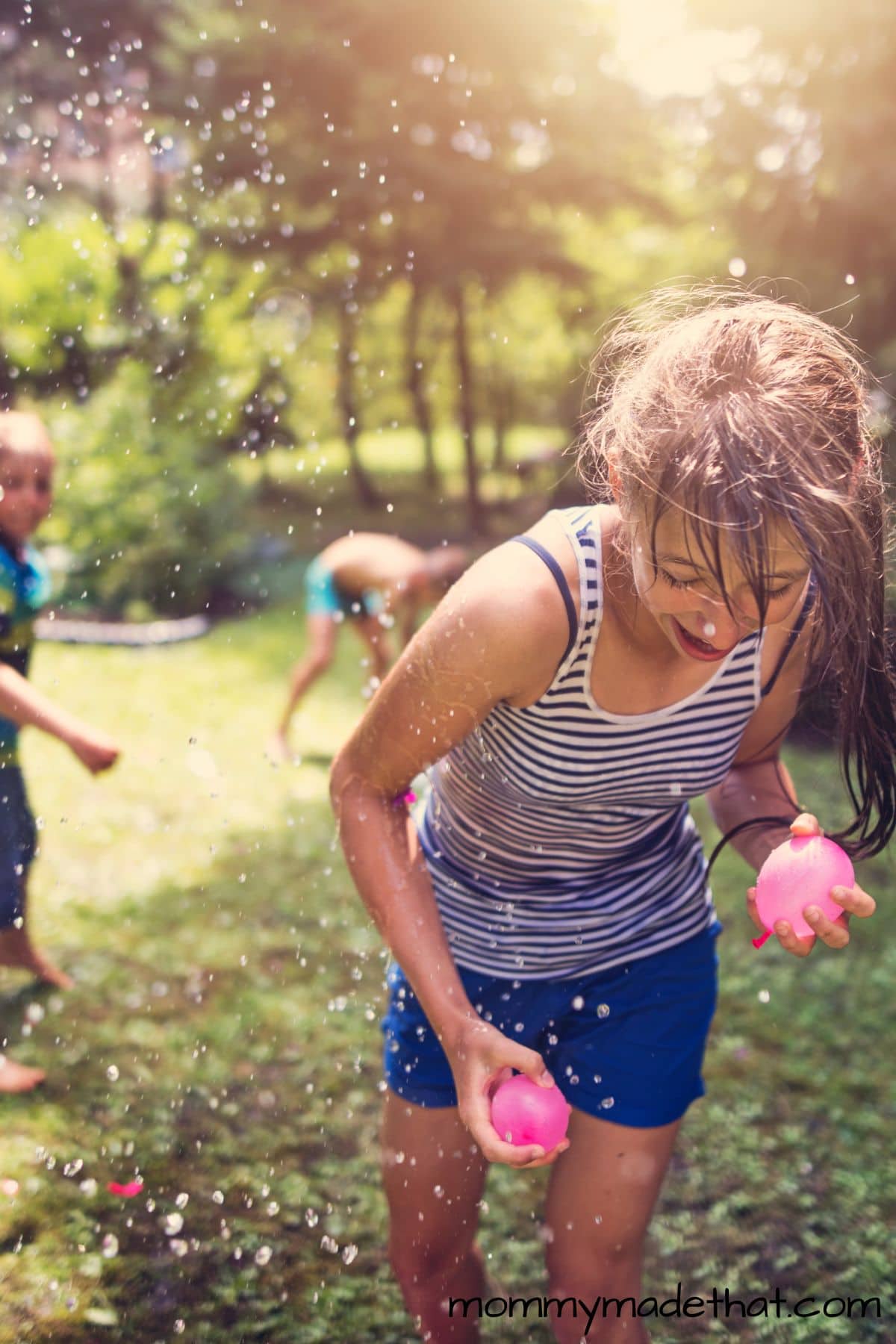
Water Balloon Toss
Water Balloon Toss is a fun and refreshing water balloon game that’s perfect for warm weather days.
How to Play:
To play, divide the group into pairs and provide each pair with a water balloon. Have the pairs stand facing each other at a close distance to start.
The objective of the game is to toss the water balloon back and forth between the partners without letting it break.
After each successful catch, the players take a step back, increasing the distance between them.
The game continues until only one pair remains with an unbroken water balloon.
For a fun challenge, try using water balloons when playing trampoline games!
Equipment:
Equipment needed for Water Balloon Toss includes water balloons and a space where players can safely get wet.
To modify the game for younger children, you can use larger water balloons or have them start at a closer distance.
For older children, you can increase the starting distance or introduce additional challenges, such as requiring players to catch the balloons with only one hand or while standing on one leg.
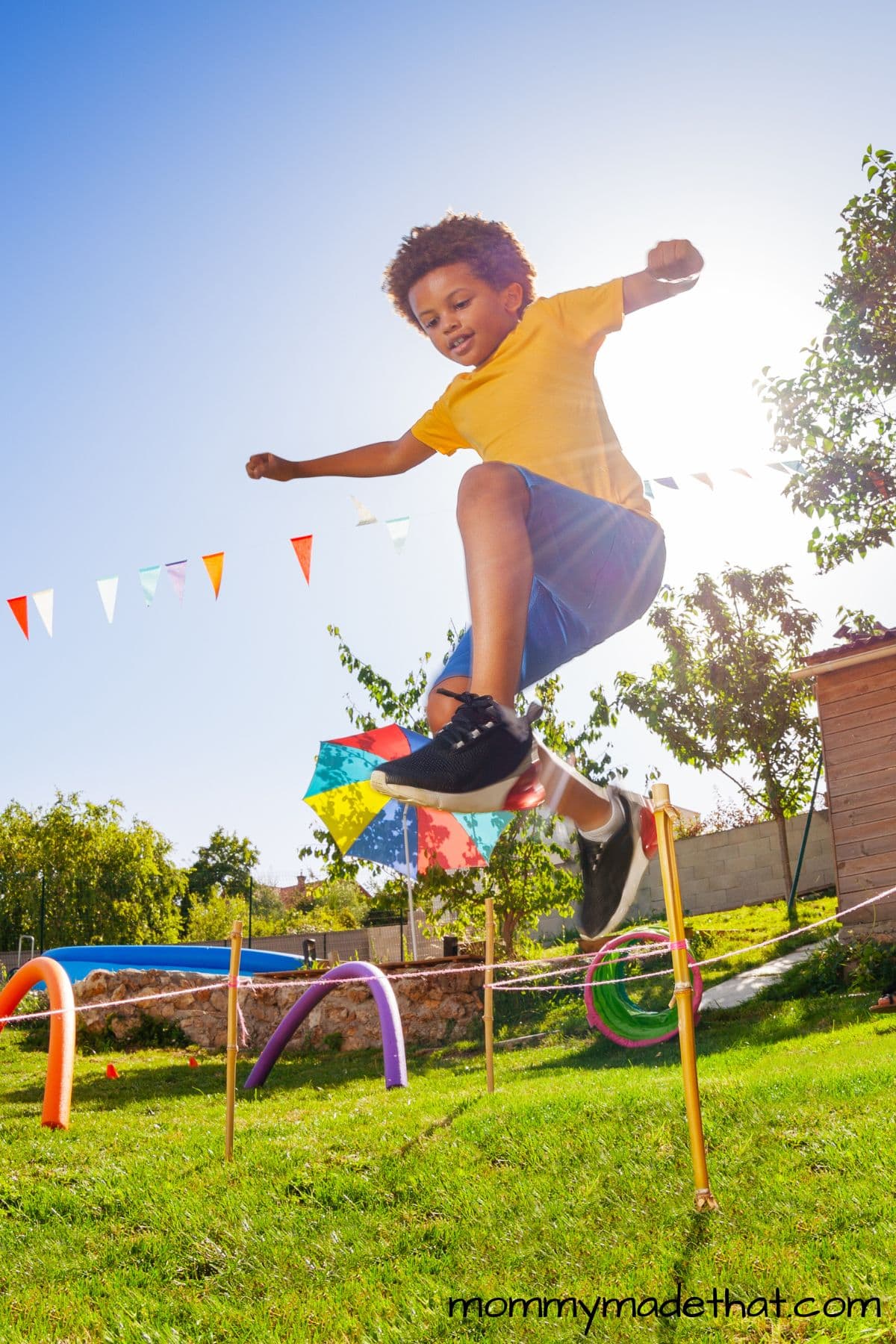
Obstacle Course
An Obstacle Course is an exciting game that promotes physical activity, coordination, and problem-solving.
How to Play:
To play, set up a series of obstacles in a designated area that players must navigate through, over, or around.
Obstacles can include cones to weave through, hurdles to jump over, tunnels to crawl through, or balance beams to walk across.
Players take turns navigating the obstacle course, either competing against each other for the fastest time or working together as a team to complete the course as quickly as possible.
Equipment:
Equipment needed for an Obstacle Course depends on the specific obstacles involved. Cones, tunnels, balance beams, and other items can be used to create a challenging and engaging course.
To modify the game for younger children, you can use fewer obstacles or decrease the difficulty level.
For older children, you can increase the complexity of the obstacles, add time limits, or introduce additional challenges, such as blindfolding players or requiring them to carry an object while navigating the course.
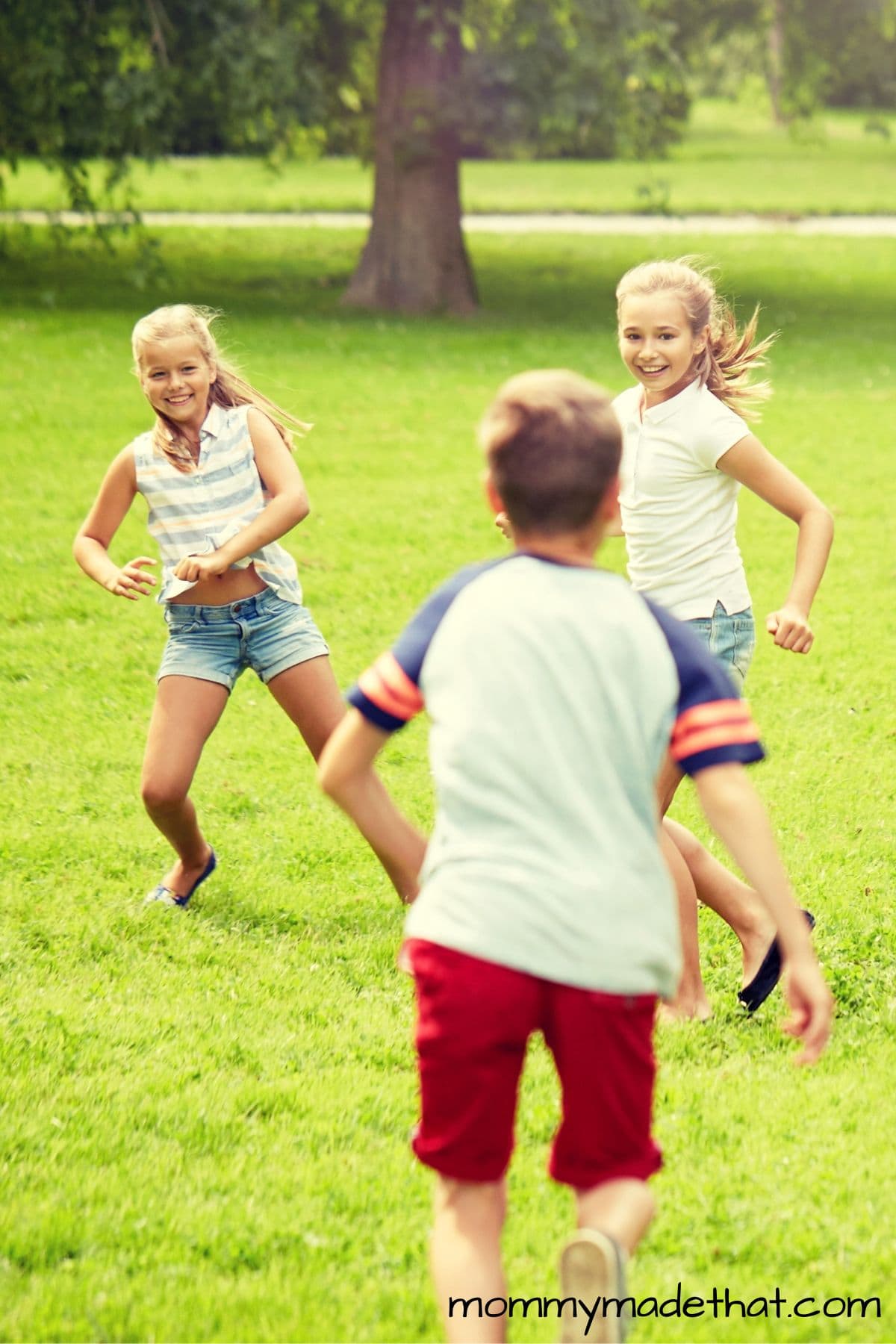
Sharks and Minnows
Sharks and Minnows is an energetic game that’s perfect for large groups and open spaces.
How to Play:
To play, designate one player as the “shark” and have them stand in the middle of the playing area. The remaining players are the “minnows” and line up at one end of the playing area.
The objective of the game is for the minnows to run from one side of the playing area to the other without being tagged by the shark. If a minnow is tagged, they become a shark and join the original shark in the next round.
The game continues until all minnows have been turned into sharks.
Equipment:
No equipment is necessary for Sharks and Minnows, making it a great game to play anywhere.
To modify the game for younger children, you can decrease the size of the playing area, have the shark move slower, or allow minnows to crawl instead of run.
For older children, you can increase the size of the playing area, add multiple sharks, or introduce additional challenges like obstacles to navigate while running.
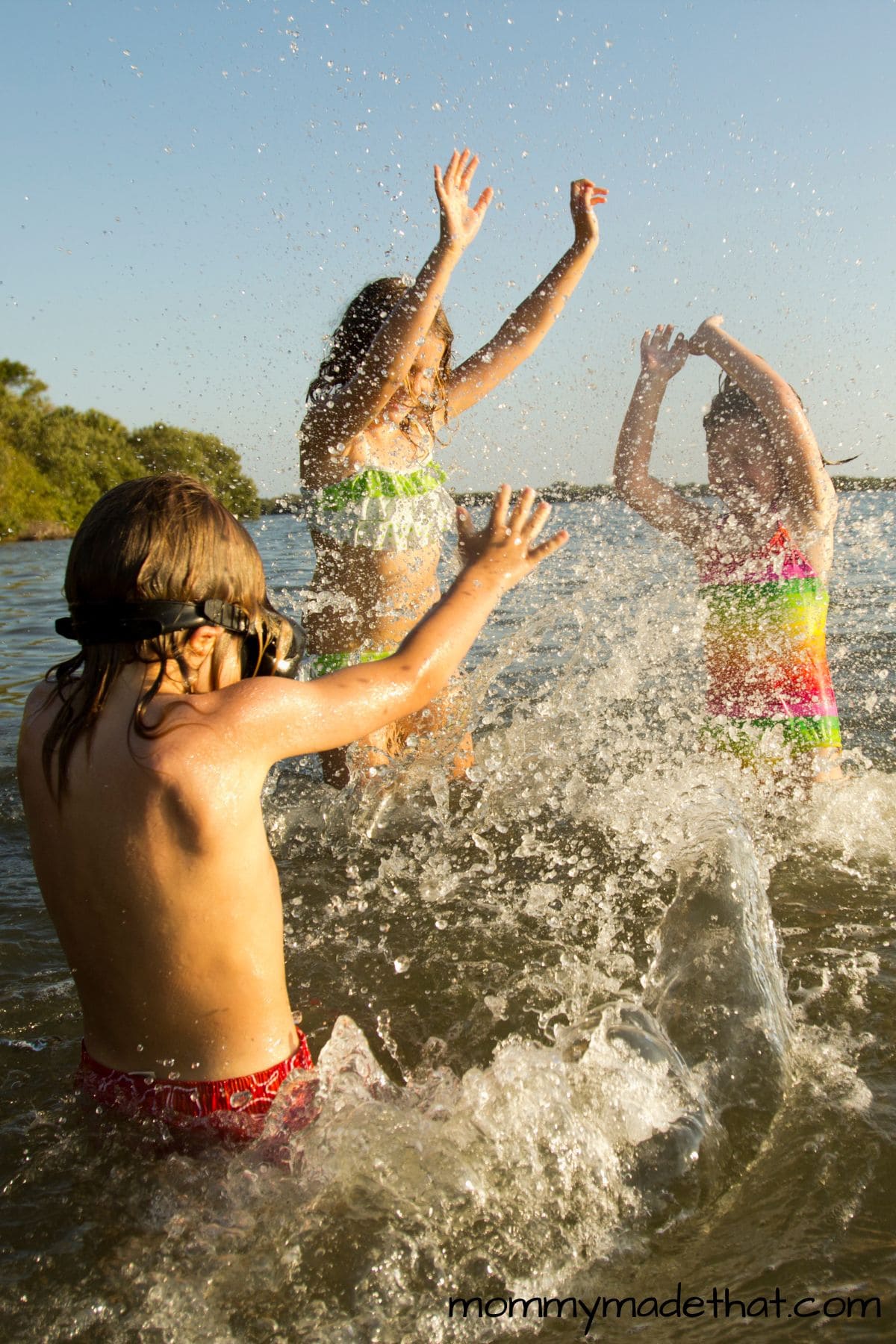
Marco Polo
Marco Polo is a classic water-based game that’s perfect for pool parties and warm weather fun.
How to Play:
To play, choose one player to be “Marco” and have them close their eyes or wear a blindfold.
The other players spread out in the pool and try to avoid being tagged by Marco.
Marco calls out “Marco,” and the other players must respond with “Polo.” Marco uses the sound of the voices to locate and tag the other players.
If a player is tagged, they become the new Marco. The game continues until everyone has had a turn as Marco or for a predetermined amount of time.
Equipment:
No equipment is necessary for Marco Polo, making it an excellent game to play in any pool.
To modify the game for younger children, you can use a smaller pool, limit the movement of players, or allow Marco to keep their eyes open.
For older children, you can add additional rules, such as requiring players to stay underwater after responding with “Polo” or introducing a “fish out of water” rule where players can exit the pool but must re-enter if Marco calls “fish out of water.”
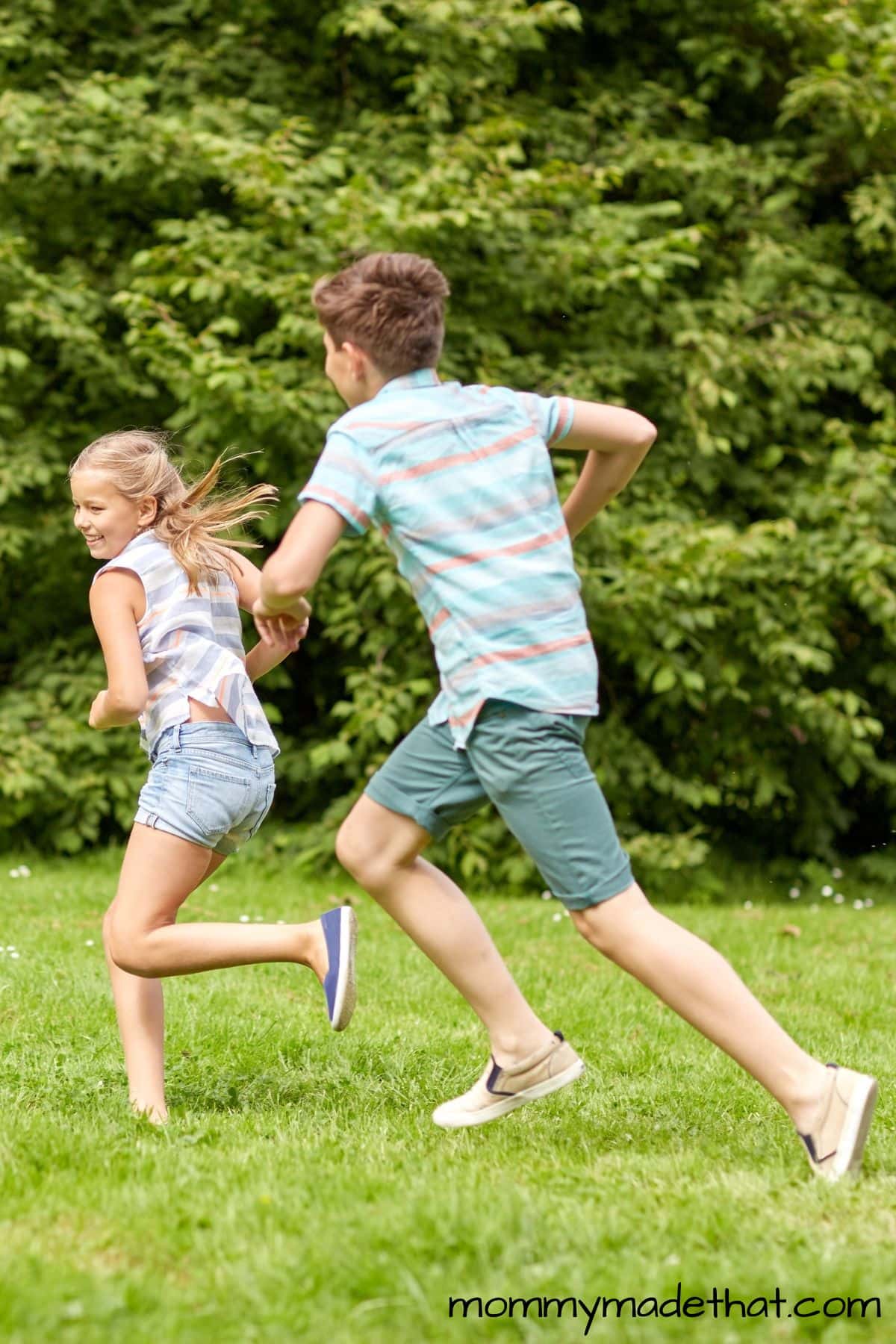
Steal the Bacon
Steal the Bacon is another fun group game for kids that promotes competitive play, quick thinking and teamwork.
How to Play:
To play, divide the group into two equal teams, and have them line up on opposite sides of a playing area. Place an object, such as a small ball or bean bag, in the middle of the playing area to represent the “bacon.”
Assign each player a number, ensuring that there is a corresponding player with the same number on the opposing team.
The game leader calls out a number, and the players with that number from both teams must race towards the bacon, trying to grab it and bring it back to their side without being tagged by the opposing player.
If a player successfully brings the bacon to their side, their team scores a point. If a player is tagged while holding the bacon, the other team scores a point.
Equipment:
No equipment is necessary for Steal the Bacon, aside from the object used as the bacon.
To modify the game for younger children, you can use a larger object for the bacon or decrease the distance between the teams and the bacon.
For older children, you can increase the distance, add obstacles, or introduce additional rules, such as requiring players to hop on one foot or crawl to retrieve the bacon.
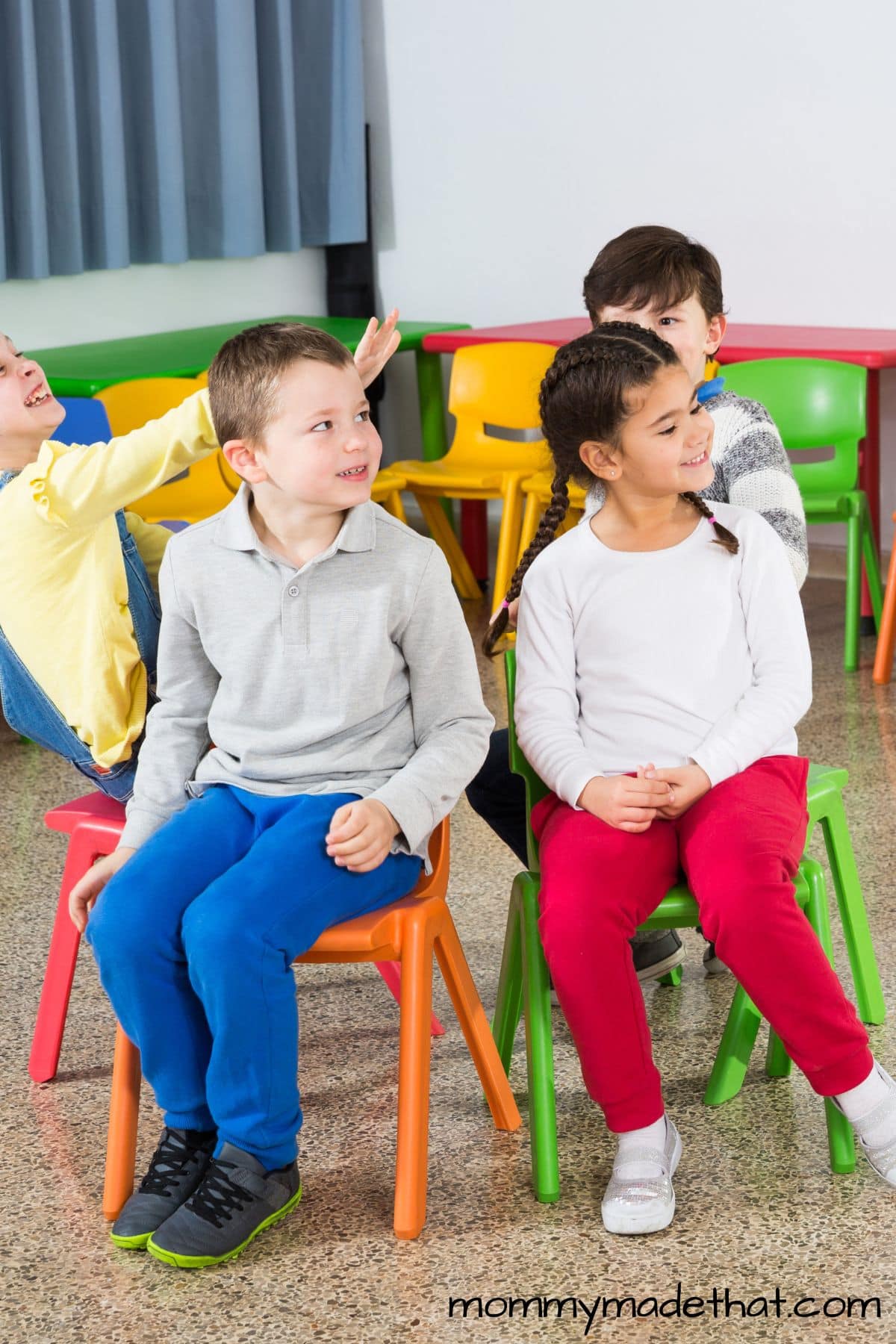
Musical Chairs
Musical Chairs is a classic party game that’s suitable for all ages.
How to Play:
To play, set up chairs in a circle, with one less chair than the number of players.
Start the music, and have the players walk around the chairs. When the music stops, players must quickly find a chair to sit on. The player left standing without a chair is out of the game.
Remove one chair after each round, and continue playing until only one player remains seated, making them the winner.
Equipment:
Equipment needed for Musical Chairs includes chairs and a music player.
To modify the game for younger children, you can use cushions instead of chairs, slow down the music, or allow players to share chairs if they cannot find an empty one.
For older children, you can increase the pace of the music, introduce a rule where players must walk backward, or add obstacles around the chairs that players must navigate while playing.

